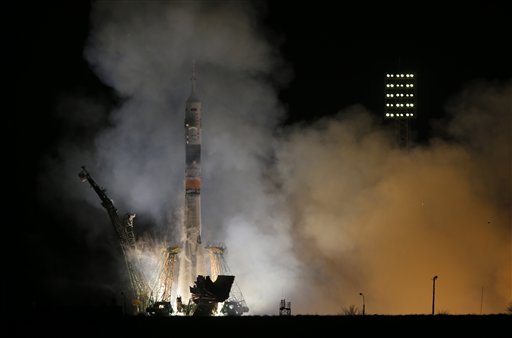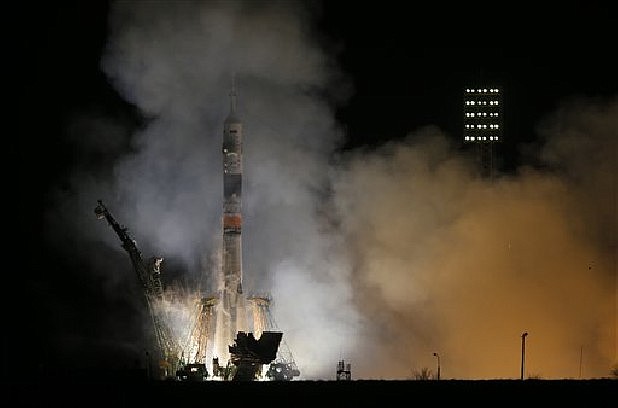 The Soyuz-FG rocket booster with Soyuz TMA-12M space ship carrying a new crew to the International Space Station blasts off at the Russian leased Baikonur cosmodrome, Kazakhstan, Wednesday, March 26, 2014. The Russian rocket carries astronaut Steven Swanson, Russian cosmonauts Alexander Skvortsov and Oleg Artemyev.
The Soyuz-FG rocket booster with Soyuz TMA-12M space ship carrying a new crew to the International Space Station blasts off at the Russian leased Baikonur cosmodrome, Kazakhstan, Wednesday, March 26, 2014. The Russian rocket carries astronaut Steven Swanson, Russian cosmonauts Alexander Skvortsov and Oleg Artemyev.MOSCOW - An engine snag has delayed the arrival of a Russian spacecraft carrying three astronauts to the International Space Station until Thursday.
A rocket carrying Russians Alexander Skvortsov and Oleg Artemyev and American Steve Swanson to the space station blasted off successfully early Wednesday from the Russian-leased Baikonur cosmodrome in Kazakhstan.
The Soyuz booster rocket lifted off as scheduled at 3:17 a.m. local time Wednesday (2117 GMT Tuesday). It entered a designated orbit about 10 minutes after the launch and was expected to reach the space station in six hours. All onboard systems were working flawlessly, and the crew was feeling fine.
NASA and Roscosmos, Russia's space agency, said shortly before the planned docking that the arrival had been delayed after a 24-second engine burn that was necessary to adjust the Soyuz spacecraft's orbiting path "did not occur as planned."
The crew is in no danger, but will have to wait until Thursday for the Soyuz TMA-12M to arrive and dock at the space station, NASA said. The arrival is now scheduled for 7:58 EDT (2358 GMT) Thursday.
Roscosmos chief Oleg Ostapenko said on Wednesday that the glitch occurred because of a failure of the ship's orientation system. The crew is in good spirits and they have taken off their space suits to prepare for the long flight, Ostapenko said in remarks carried by Russian news agencies.
The Russian official said the crew is now working to adjust the spacecraft to the right orbit to make it for the Thursday docking.
Russian spacecraft used to routinely travel two days to reach the orbiting laboratory before last year. Wednesday would have been only the fifth time that a crew would have taken the six-hour "fast-track" route to the station.
Russian officials would not immediately pinpoint the cause of the glitch. The Interfax news agency, however, quoted Vitali Lopota, chief of Russia's RKK Energia state-controlled rocket manufacturer, as saying that the failure of the spacecraft's software is to blame. They are looking into other possible causes too, Lopota said.
The three astronauts traveling in the Soyuz will be greeted by Japan's Koichi Wakata, NASA's Rick Mastracchio and Russia's Mikhail Tyurin, who have been at the station since November. Wakata is the first Japanese astronaut to lead the station. The new crew is scheduled to stay in orbit for six months.
The joint mission is taking place at a time when U.S.-Russian relations on Earth are at their lowest ebb in decades, but the U.S. and Russia haven't allowed their disagreements over Ukraine to get in the way of their cooperation in space.
Swanson is a veteran of two U.S. space shuttle missions, and Skvortsov spent six months at the space outpost in 2010. Artemyev is on his first flight to space.
So far, the tensions between the U.S. and Russia over Ukraine have been kept at bay. Since the retirement of the U.S. space shuttle fleet in 2011, NASA has relied on Russian Soyuz spacecraft as the only means to ferry crew to the orbiting outpost and back.
The U.S. is paying Russia nearly $71 million per seat to fly astronauts to the space lab through 2017. It's doing that at a time when Washington has led calls for sanctions on Russia over its annexation of Crimea from Ukraine following a hastily-arranged referendum. So far the sanctions have been limited and haven't directly targeted the wider Russian economy.
Earlier this month, NASA Administrator Charles Bolden repeatedly said the conflict in Ukraine would have no effect on what's going on in space between the U.S. and Russia, saying that the "partnership in space remains intact and normal."
At the same time, Bolden said on his blog Tuesday that while NASA continues to cooperate successfully with Russia, it wants to quickly get its own capacity to launch crews. NASA is trying to speed up private American companies' efforts to launch crews into orbit, but it needs extra funding to do so.
